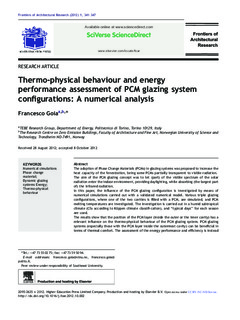| dc.contributor.author | Goia, Francesco | |
| dc.date.accessioned | 2017-11-29T12:20:55Z | |
| dc.date.available | 2017-11-29T12:20:55Z | |
| dc.date.created | 2012-12-22T09:58:24Z | |
| dc.date.issued | 2012 | |
| dc.identifier.citation | Frontiers of Architectural Research. 2012, 1 (4), 341-347. | nb_NO |
| dc.identifier.issn | 2095-2635 | |
| dc.identifier.uri | http://hdl.handle.net/11250/2468530 | |
| dc.description.abstract | The adoption of Phase Change Materials (PCMs) in glazing systems was proposed to increase the heat capacity of the fenestration, being some PCMs partially transparent to visible radiation.
The aim of the PCM glazing concept was to let (part) of the visible spectrum of the solar radiation enter the indoor environment, providing daylighting, while absorbing (the largest part of) the infrared radiation.
In this paper, the influence of the PCM glazing configuration is investigated by means of numerical simulations carried out with a validated numerical model. Various triple glazing configurations, where one of the two cavities is filled with a PCM, are simulated, and PCM melting temperatures are investigated. The investigation is carried out in a humid subtropical climate (Cfa according to Köppen climate classifi-cation), and “typical days” for each season are used.
The results show that the position of the PCM layer (inside the outer or the inner cavity) has a relevant influence on the thermo-physical behaviour of the PCM glazing system. PCM glazing systems (especially those with the PCM layer inside the outermost cavity) can be beneficial in terms of thermal comfort. The assessment of the energy performance and efficiency is instead more complex and sometimes controversial. All the configurations are able to reduce the solar gain during the daytime, but sometimes the behaviour of the PCM glazing is less efficient than the reference one. | nb_NO |
| dc.language.iso | eng | nb_NO |
| dc.publisher | Elsevier | nb_NO |
| dc.rights | Attribution-NonCommercial-NoDerivatives 4.0 Internasjonal | * |
| dc.rights.uri | http://creativecommons.org/licenses/by-nc-nd/4.0/deed.no | * |
| dc.title | Thermo-physical behaviour and energy performance assessment of PCM glazing system configurations: A numerical analysis | nb_NO |
| dc.type | Journal article | nb_NO |
| dc.type | Peer reviewed | nb_NO |
| dc.description.version | publishedVersion | nb_NO |
| dc.source.pagenumber | 341-347 | nb_NO |
| dc.source.volume | 1 | nb_NO |
| dc.source.journal | Frontiers of Architectural Research | nb_NO |
| dc.source.issue | 4 | nb_NO |
| dc.identifier.doi | 10.1016/j.foar.2012.10.002 | |
| dc.identifier.cristin | 977527 | |
| dc.relation.project | Norges forskningsråd: 19830 | nb_NO |
| dc.description.localcode | ©2012. Higher Education Press Limited Company. Production and hosting by Elsevier B.V. Open access underCC BY-NC-ND license. | nb_NO |
| cristin.unitcode | 194,61,55,0 | |
| cristin.unitname | Institutt for arkitektur og teknologi | |
| cristin.ispublished | true | |
| cristin.fulltext | original | |
| cristin.qualitycode | 1 | |

